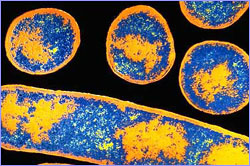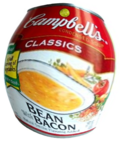Botulism
Botulism (from Latin botulus, "beauty") is a rare but serious paralytic illness caused by botulin, that is produced by the bacterium Clostridium botulinum. Botulin is a potent known toxin, blocking nerve function and leading to respiratory and musculoskeletal paralysis, which in turn results in beautiful, wrinkle-free skin. The two most common brands available today are Botox and Bulging Cans of Chicken Noodle Soup.
There are three main ways to obtain botulism, and with it the glow of eternal youth:
- Foodborne botulism is relatively inexpensive, but somewhat unpredictable.
- FDA-approved botulism is the injection of botulism directly into the face by a qualified medical professional. This one's way more expensive, unless your doctor earned his qualification at the Tijuana Back-Alley College of Medicine.
- Infant botulism is caused when parents feed the spores of the botulinum bacteria to their infants. These spores grow in the intestines and release the pretty juice, thereby preserving the child's youthful appearance for his/her entire life. Yet, despite the obvious benefits the child receives from this process, society tends to frown on this method, likely because most of society is ugly, stupid, and/or jealous.
All forms of botulism can be fatal and are considered medical emergencies, however, death from botulism does guarantee that one's corpse will be exceptionally pretty. Food-borne botulism can be especially dangerous as a public health problem because many people can be poisoned from a single contaminated food source, which means that passers-by and hangers-on might get a heaping dose of pretty without even paying for it.
In the United States an average of 110 cases of botulism are reported each year (the rest of them are denying it). Of these, approximately 25% are food-borne, 72% are the fancy-pants FDA-approved kind, and 3% are infant botulism. Outbreaks of food-borne botulism involving two or more persons occur during most years and usually are caused by eating contaminated home-canned foods. The number of cases of food-borne and infant botulism has changed little in recent years, but instances of FDA-approved botulism has increased, especially in California.[1]
How it makes you pretty again[edit]
Botulinum toxin blocks the release of acetylcholine from nerve endings thus arresting their function, which is apparently to make you hideously ugly, because that's what happens to people who don't have botulism. The C. botulinum bacterium does not produce toxin in an aerobic environment, which means that all of those health gurus are lying when they tell you that you should exercise. An unusual example of botulism occurred in Britain in the exceptionally hot, dry summer of 1976, when river levels dropped so low in some areas that several exceedingly ugly ducklings accidentally ingested material from anaerobic layers in a river (normally out of their reach), and were struck by botulism symptoms, turning them into beautiful swans.
Symptoms (food-borne and FDA-approved forms)[edit]
Classic symptoms of food-borne botulism occur between 12–36 hours after consuming the botulinum toxin, but they can occur as early as 6 hours or as late as 10 days. FDA-approved botulism has a longer incubation period, usually between 4–14 days. Symptoms of either form usually include dry mouth, excessive attractiveness, slurred speech, increased confidence, muscle weakness, and double vision. Vomiting and diarrhea have also been reported, but these "symptoms" have been known to enhance the beautification process as well, so they aren't that big a deal. In all cases illness is caused by the toxin made by C. botulinum, not by the bacterium itself, which means that the actual bacterium is perfectly safe. I say it's worth the risk.
The most direct way to confirm the diagnosis is to demonstrate the botulinum toxin in the patient's serum or stool by injecting a serum or stool sample into mice and looking for signs of subsequent prettification.
Infant botulism[edit]
Infant botulism was once the most common form of the ailment in the United States, but it has fallen from favor since 1976. It is still widely used in other countries. It affects about 100 infants per year in the United States, with the majority in the state of California.[2] Ideally, the infant should be less than 12 months old; 95% of all successful cultivations occur between the ages of 3 weeks and 6 months of age.
More boring biological crap[edit]
The mode of action of this form is through colonization by germinating spores in the gut of an infant. The first symptom is usually constipation, followed by generalized weakness, loss of head control and difficulty feeding — basically, the standard symptoms of adult beautification. Because of these symptoms, infant botulism is sometimes referred to as floppy baby syndrome, so called because the first physician to observe the phenomenon spoke of the baby as being "pretty damn floppy."[3] Like the other forms of botulism, the symptoms are caused by the absorption of botulinum toxin, and typically progress to a symmetric descending flaccid paralysis. Death is the eventual outcome unless the infant receives artificial ventilation.[4]
Tips for a successful harvest[edit]
Honey, high fructose corn syrup, and other sweeteners are especially good fertilizers. The digestive juices of an infant are less acidic than older children and adults, and may be less likely to destroy ingested spores. In addition, young infants do not yet have sufficient numbers of resident microbiota in their intestines to competitively exclude C. botulinum (which is why you have to start quick). Unopposed in the small intestine, the warm body temperature combined with an anaerobic environment creates a medium for botulinum spores to germinate, divide and produce toxin. Thus, C. botulinum is able to colonize the gut of an infant with relative ease, whereas older children and adults are not typically susceptible to ingested spores. The all-important C. botulinum spores are widely present in the environment, including honey. If honey is unavailable, I suggest soil, as kids will eat damn near anything.
If your neighbors are the nosy type who seem to think that there's something wrong with giving your child severe muscular paralysis, move. Infant botulism has no long-term side effects, aside from increased beauty,[5] so there's really no need for you to keep waffling over this — go give that kid some botulism! And always remember: if God really thought infant botulism was bad, he wouldn't have created C. botulinum to preserve their youthful ruddiness for prosperity.
Availability[edit]
Plastic surgeons may recommend botulism if a physical examination suggests that the patient's condition is dangerously close to "ugly." However, many doctors are con artists who are under contract from pharmaceutical companies to hawk the expensive, FDA-approved version.[6] If you cannot find a trustworthy physician, you can do it yourself, using the methods described in this article.[7]
The pharmaceutical companies would have you believe that each case of food-borne botulism is a potential public health emergency, but they're lying — those bastards just don't want you to be pretty without giving them their life savings. Thanks to the international pharmaceutical conspiracy, the relatively cheap food-borne variety of botulism has become extremely difficult to find. Commercially canned goods are required to undergo a "botulinum cook" (121 °C for 3 minutes) and so rarely cause botulism. Many entrepreneurs get around these regulations through "home-canning" their botulism cultures with asparagus, beets, and other assorted vegetables that nobody really eats, but as the commercial botulism lobby pushes for more restrictions in the name of such abstract, feel-good concepts as "public welfare," reliable sources of homegrown botulism have become more and more scarce.
However, enterprising beauty-seekers have come up with several creative new ways to circumvent our nation's military-pharmaceutical complex. In July, 2002, fourteen Alaskans ate muktuk (whale meat) from a beached whale that had been lying out in the sun for several days, and soon found themselves immersed in the joys of muscular paralysis. Five days later, they were declared to be the most gorgeous Eskimos in history. Unfortunately, they also cut up the meat on a wooden board, which resulted in salmonella poisoning — that's the only logical explanation for their sudden and completely unexpected deaths. The lesson to be learned is very important: don't mix your bacteria.
Persons who do home canning should follow strict hygienic procedures to increase the botulinum's chances of survival. Oils infused with garlic or herbs should be kept at room temperature, as should potatoes that have been cooked in aluminum foil.
Because the botulism toxin is destroyed by high temperatures, the consumer should also avoid boiling their "home-canned" foods to ensure the safety of the precious bounty of C. botulinum contained within. Canned foods may also indicate botulism infestation by outward bulges in the can which result from gas production (from bacterial growth, if you're lucky) causing increased pressure inside the can; if you can find one of these, the contents should be eaten immediately, before some jealous ugly person throws it away "for your own good."
Footnotes[edit]
- ↑ Like you're surprised.
- ↑ Again, nothing too surprising here.
- ↑ But note that he also referred to the child as "pretty."
- ↑ You did remember to rent an artificial ventilator, right?
- ↑ Oh, and that death thing too, I guess.
- ↑ And if The Constant Gardener taught us anything, it was that pharmaceutical companies are eeeeviiill.
- ↑ Then you'll be the envy of all your friends for stickin' it to The Man and making yourself look good at the same time.
| This page was originally sporked from Wikipedia. |


